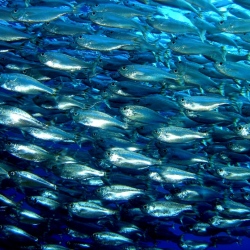
The University of Tübingen’s Institute of Anatomy has discovered a fish with a previously unknown type of eye. The aptly-named glasshead barreleye lives at depths of 800 to 1000 meters. It has a cylindrical eye pointing upwards to see prey, predators or potential mates silhouetted against the gloomy light above.
The eye also has a mirror-like second retina which can detect bioluminescent flashes created by deep-sea denizens to the sides and below, reports Professor Hans-Joachim Wagner in the latest Proceedings of the Royal Society B.
Professor Wagner examined an 18cm long glasshead barreleye, rhynchohyalus natalensis, caught in the Tasman Sea between Australia and New Zealand, as part of an international research project.
The results were unexpected; reflector eyes are usually only found in invertebrates, such as mollusks and crustaceans, although one other vertebrate, the deep-sea brownsnout spookfish or dolichopteryx longipes, also uses a combination of reflective and refractive lenses in its eyes.
The light coming from below is focused onto a second retina by a curved mirror composed of many layers of small reflective plates made of guanine crystals, giving the fish a much bigger field of vision.
The glasshead barreleye is therefore one of only two vertebrates known to have reflector eyes; but significantly, although rhynchohyalus natalensis and dolichopteryx longipes belong to the same family, their reflective lenses have a different structure and appear to have developed from different kinds of tissue.
That indicates that two related but different genera took different paths to arrive at a similar solution, the reflective optics and a second retina to supplement the limited vision of the conventional refractive cylindrical eye.
